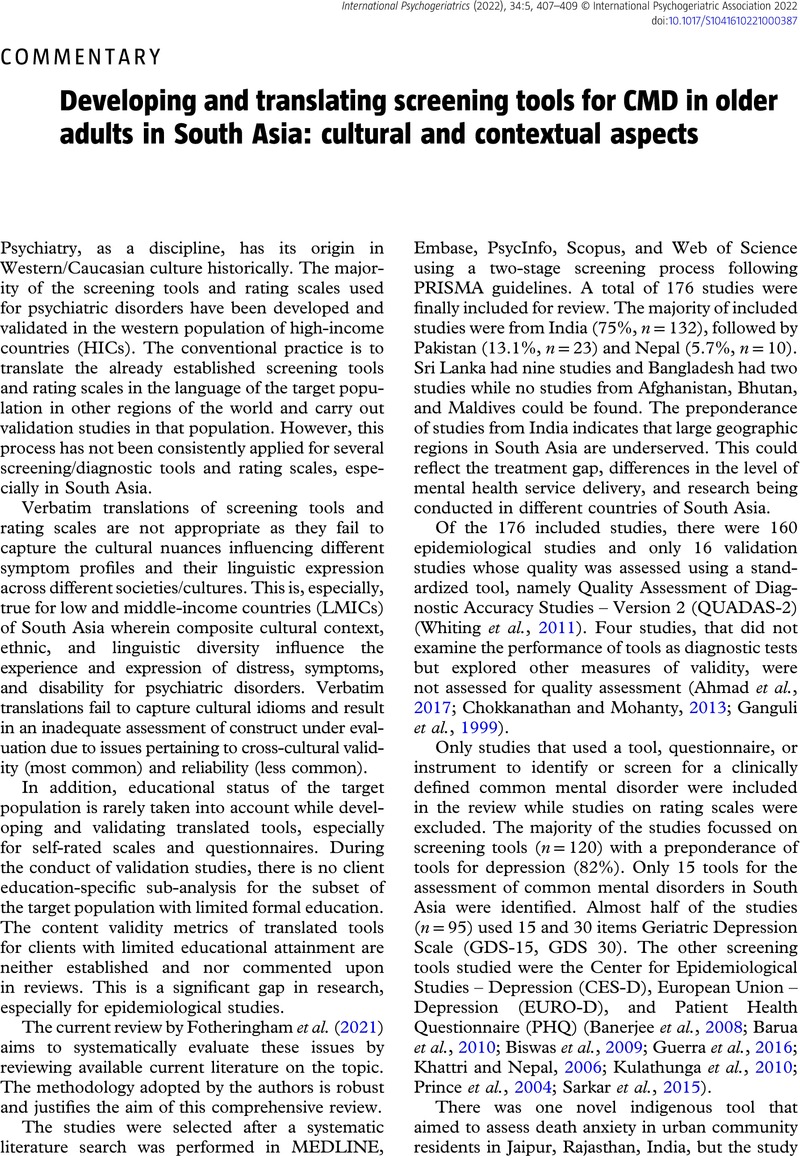No CrossRef data available.
Article contents
Developing and translating screening tools for CMD in older adults in South Asia: cultural and contextual aspects
Published online by Cambridge University Press: 24 January 2022
Abstract
An abstract is not available for this content so a preview has been provided. Please use the Get access link above for information on how to access this content.

- Type
- Commentary
- Information
- International Psychogeriatrics , Volume 34 , Special Issue 5: Issue Theme: Advances in Assessment of Psychopathology , May 2022 , pp. 407 - 409
- Copyright
- © International Psychogeriatric Association 2022
References
Ahmad, S., Hussain, S., Shah, F. S. and Akhtar, F. (2017). Urdu translation and validation of GAD-7: a screening and rating tool for anxiety symptoms in primary health care. Journal of Pakistan Medical Association, 67, 1536–1540.Google ScholarPubMed
Banerjee, A., Kumar, S., Kulhara, P. and Gupta, A. (2008). Prevalence of depression and its effect on disability in patients with age- related macular degeneration. Indian Journal of Ophthalmology, 56, 469–474.Google ScholarPubMed
Barua, A., Ghosh, M., Kar, N. and Basilio, M. (2010). Distribution of depressive disorders in the elderly. Journal of Neurosciences in Rural Practice, 1, 67–73. https://doi.org/10.4103/0976-3147.71719
Google ScholarPubMed
Biswas, S. S. et al. (2009). Depression in the elderly in Vellore, South India: the use of a two-question screen. International Psychogeriatrics, 21, 369–371. https://doi.org/10.1017/S1041610208008259
CrossRefGoogle ScholarPubMed
Chokkanathan, S. and Mohanty, J. (2013). Factor structure of the CES-D scale among older adults in Chennai, India. Aging and Mental Health, 17, 517–525. https://doi.org/10.1080/13607863.2012.751580
CrossRefGoogle ScholarPubMed
Fotheringham, L., Paddick, S., Barron Millar, E., Norman, C., Lukose, A., Walker, R. and Varghese, M. (2021). Screening tools for common mental disorders in older adults in South Asia: A systematic scoping review. International Psychogeriatrics, 1–12. doi:10.1017/S1041610220003804.CrossRefGoogle ScholarPubMed
Ganguli, M., Dube, S., Johnston, J. M., Pandav, R., Chandra, V. and Dodge, H. H. (1999). Depressive symptoms, cognitive impairment and functional impairment in a rural elderly population in India: a Hindi version of the geriatric depression scale (GDS-H). International Journal of Geriatric Psychiatry, 14, 807–820.3.0.CO;2-#>CrossRefGoogle Scholar
Guerra, M. et al. (2016). A comparative cross-cultural study of the prevalence of late life depression in low and middle income countries. Journal of Affective Disorders, 190, 362–368. https://doi.org/10.1016/j.jad.2015.09.004
CrossRefGoogle ScholarPubMed
Haro, J. M. et al. (2006). Concordance of the Composite International Diagnostic Interview Version 3.0 (CIDI 3.0) with standardized clinical assessments in the WHO World Mental Health surveys. International Journal of Methods in Psychiatric Research, 15, 167–180. https://doi.org/10.1002/mpr.196
CrossRefGoogle ScholarPubMed
Khattri, J. B. and Nepal, M. K. (2006). Study of depression among geriatric population in Nepal. Nepal Medical College Journal, 8, 220–223.Google ScholarPubMed
Kulathunga, M., Umayal, S., Somaratne, S., Srikanth, S., Kathriarachchi, S. and De Silva, K. (2010). Validation of the geriatric depression scale for an elderly Sri Lankan clinic population. Indian Journal of Psychiatry, 52, 254–256. https://doi.org/10.4103/0019-5545.70979
Google ScholarPubMed
Madnawat, A. V. S. and Kachhawa, P. S. (2007). Age, gender, and living circumstances: discriminating older adults on death anxiety. Death Studies, 31, 763–769. https://doi.org/10.1080/07481180701490743
CrossRefGoogle ScholarPubMed
Office of The Registrar General of India. (2011). Census of India 2011: Language [Online]. Available at: https://censusindia.gov.in/2011Census/C-16_25062018_NEW.pdf; last accessed 1 January 2021.Google Scholar
Pilania, M. et al. (2019). Prevalence of depression among the elderly (60 years and above) population in India, 1997–2016: a systematic review and meta-analysis. BMC Public Health, 19, 832. https://doi.org/10.1186/s12889-019-7136-z
CrossRefGoogle ScholarPubMed
Prince, M. et al. (2004). Effects of education and culture on the validity of the Geriatric Mental State and its AGECAT algorithm. British Journal of Psychiatry, 185, 429–436. https://doi.org/10.1192/bjp.185.5.429
CrossRefGoogle ScholarPubMed
Sarkar, S., Kattimani, S., Roy, G., Premarajan, K.C. and Sarkar, S. (2015). Validation of the Tamil version of short form Geriatric Depression Scale-15. Journal of Neurosciences in Rural Practice, 6, 442–446. https://doi.org/10.4103/0976-3147.158800
Google ScholarPubMed
Thapa, D. K., Visentin, D., Kornhaber, R. and Cleary, M. (2018). Prevalence of mental disorders among older people in nepal: a systematic review. Kathmandu University Medical Journal (KUMJ), 16, 181–190.Google ScholarPubMed
Whiting, P. F. et al. (2011). QUADAS-2: a revised tool for the quality assessment of diagnostic accuracy studies. Annals of Internal Medicine, 155, 529–536. https://doi.org/10.7326/0003-4819-155-8-201110180-00009
CrossRefGoogle ScholarPubMed




